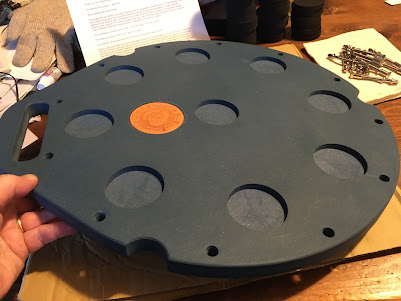(This review will be delivered in multiple parts.)
Beetle Percussion, a one-man show delivering beautifully crafted and sustainable practice pads made entirely in the USA, has entered the world of high-zoot, tunable practice pads with something called the Last Pad.
Though a carry handle has been incorporated into the design, this is a pad that’s intended for stationary use in the practice room or studio, and not meant for easy and regular transport. The assembled pad weighs just over sixteen pounds, making it even heavier than some entry-level, “Junior” marching snare drums. More on the weight later.
It’s a double-sided pad that allows the player two different surfaces and tensions: the primary side takes a high-tension marching drum head and offers a feel similar to that of a modern, Kevlar-topped marching snare drum. The other side can be set up with a standard coated head and softer feel, great with concert sticks and brushes (the 14” head allows the full size desired for brush work).
As explained at the website for the pad, the small pucks and larger inserts can be utilized in multiple combinations to give a range of responses and feels, especially on the lower-tension side. This flexibility is one of the most interesting and enlightening features of this design. The patient drummer will enjoy exploring different ways to enjoy this pad. However, with twelve tension points, you’ll spend a fair amount of time assembling, dismantling and reassembling the pad until you arrive at the combination that’s optimal for you. So be prepared to set aside some quality time with the pad on a rainy afternoon.
The pad arrived at my home carefully packed and unassembled, with individual pieces wrapped in packing paper and the small pucks and tension hardware in little cloth bags. The box also included an envelope with printed instructions and pictures. The instructions included a tip to check the website for further information. The instructions are clear and helpful, but a glance at the website was also useful. My pad came with two heads: a Remo Falams II for the hard marching side and a Remo coated Emperor for the softer side.
There are two hoops, one for each side. Standard models come with S-Hoops. My pad came with less costly and lighter triple-flanged hoops, and I confess that I prefer these to the S-Hoops. They’re not only lighter in weight, but give a standard rim height above the head that makes it easier for me to find and place rimshots. S-Hoops are stronger, heavier and sit lower to the head, none of which I especially need.
The base of the pad is a solid piece of molded Valchromat, pre-drilled for the tension rods and inset on the harder marching side with a layer of Beetle’s well-known recycled tire rubber. This is the side for the Kevlar head.
The other side of the pad has smaller concave areas drilled out to take the little pucks. There are three sets of pucks, and you can glance at the website to see how they work. Choose your pucks and the arrangement on this side, then cover them with one of the three separate inserts (3/16” rubber, 1/4” rubber or 1/2” foam) to achieve the desired density under the second head.
The design is meant to avoid the pitfalls of other tensioned marching pads currently available. Rather than tensioning only one side of the pad and risking warping of the wood base — something I’ve seen with such pads — the tensioning of two opposing heads with longer rods means that the tension of all pieces being held together takes the pressure, rather than a single surface which can warp when over-tensioned.
My first assembly of the pad utilized:
Marching side: 3/16” insert and Kevlar head
Concert side: midsize foam pucks, 1/4” insert and coated Emperor head.
Assembly is best done on a table. Use the enclosed cardboard separators as a work surface to avoid scratching your tabletop. Use the regular hoop for the marching side, and the larger-drilled hoop for the softer side. Be patient and follow the directions. I used a drum torque key and a small crescent wrench to do this work, but you may find it easier to use a drum key drill bit (carefully!) and a fixed size wrench.
When everything is together, it will take multiple turns by hand to get the tension where you want it. Note: The hoop on the softer side should end up being flush with the base.







No comments:
Post a Comment